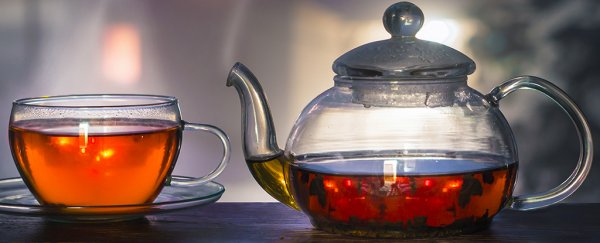The World Health Organisation advises we wait for our morning cup of English breakfast to cool slightly to decrease the risk of getting cancer of the oesophagus. But just how hot is too hot?
Until now, most research has been rather vague on the actual temperature part. After all, what is scalding to one person might be another's perfect brew. At last we have a number to help you decide when to take your first sip.
An international team of researchers have come together to objectively nail down a Goldilocks temperature for drinkers of hot beverages, and found that once the drinking liquid creeps past 60 degrees Celsius (140 degrees Fahrenheit), you're taking your chances.
To give you a sense of what that feels like, most of us will start to experience discomfort when we touch a surface that's approaching 50 degrees Celsius. So unless you're something of a masochist when it comes to that first mouthful, the news isn't all that bad.
"Many people enjoy drinking tea, coffee, or other hot beverages," says Farhad Islami from the American Cancer Society.
"However, according to our report, drinking very hot tea can increase the risk of oesophageal cancer, and it is therefore advisable to wait until hot beverages cool down before drinking."
There's plenty of research telling us the temperature of our drinks can affect our chances of developing cancer. Exactly how it does this isn't clear, but the evidence suggests damage caused by blanching our throat's cells is probably responsible.
Most studies on the topic focus on the more popular habit of tea drinking, asking participants to comment on how they prefer their water.
It might be a quick and easy way to collect data, but few people are likely to offer precise figures. So advisory groups such as the WHO's International Agency for Research on Cancer lean on animal studies that suggest 65 degrees Celsius is a suitable cut-off limit.
To improve on previous studies, researchers initiated an investigation in Golestan Province, northeast of Iran – an area already subjected to scientific scrutiny for both its culture of tea drinking and its relatively high incidence of oesophageal cancer.
An added bonus was the low incidence of smoking and alcohol drinking, habits which could have affected results.
Starting in 2004, trained data collectors gathered information on more than 50,000 participants, recording details on everything from their smoking habits to their socioeconomic status to how long they tended to wait before drinking their tea. They were then followed up over the years with phone calls, checking in on their health.
Most importantly, the team served tea during the initial interview calibrated to a piping hot 75 degrees. Guests were then invited to take a sip and comment whether it felt close to the temperature they preferred.
For those who liked it a little cooler, the team let the water's temperature fall another five degrees before asking again.
The end results sound a little concerning. Those who drink less than 700 millilitres of tea (roughly two mugs worth) heated to more than 60 degrees Celsius nearly doubled their risk of developing cancer of the oesophagus compared with 'cooler' drinkers.
Of course, we need to put those numbers into perspective. This form of cancer ranks around number eight in most common cancers, with a lifetime risk for those in the US of around 1 in 132 men and 1 in 455 women.
For those in other parts of the world, such as Iran and China, it's a far more common disease, with other contributory factors to do with diet and smoking affecting incidence rates.
Before you ditch the kettle, it helps to keep in mind drinking tea – especially of the green variety – just might help lower risks of a variety of cancers.
Evidence is mixed, but having a few cups of unsweetened tea a day probably isn't going to do much harm.
Just make sure you hold off for a few minutes to let it cool first.
This research was published in the International Journal of Cancer.
